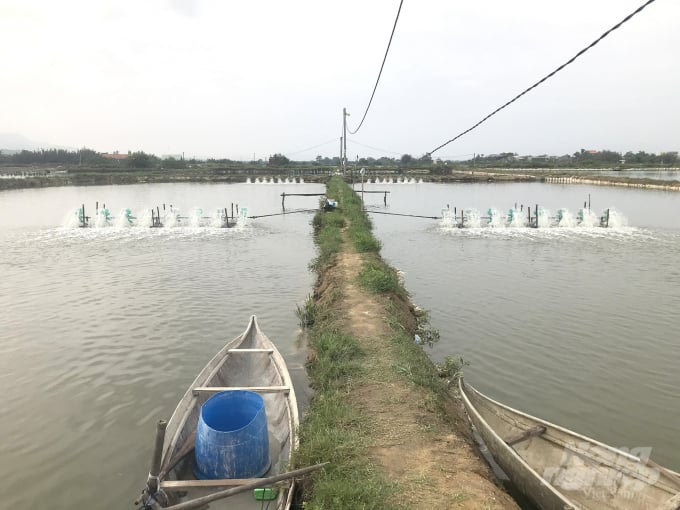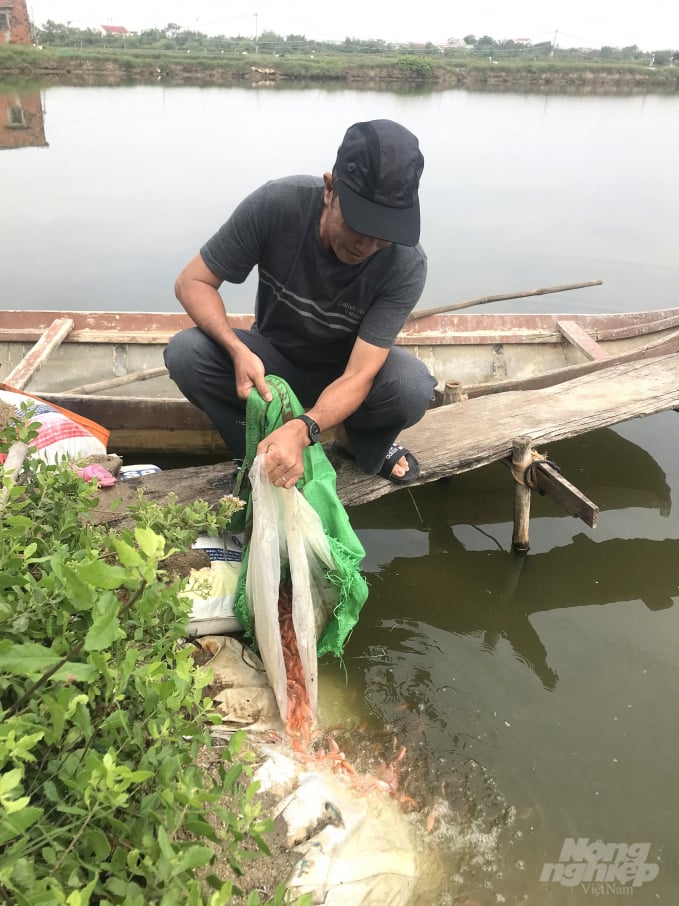May 24, 2025 | 12:14 GMT +7
May 24, 2025 | 12:14 GMT +7
Hotline: 0913.378.918
May 24, 2025 | 12:14 GMT +7
Hotline: 0913.378.918
According to Binh Dinh sub-Department of Fisheries, some shrimp farming areas are yet to be planned, leading to serious water pollution and it is the main cause of shrimp diseases.
Reality shows that the number of spontaneous shrimp farming areas with weak infrastructure has outnumbered those being planned in Binh Dinh. The extensive shrimp farming areas do not have a separate water supply system into the pond and a separate wastewater discharge system, but discharge directly into the environment instead, leading to the spread of pollution.

Water contamination is the main cause of shrimp disease. Photo: Vu Dinh Thung.
In the context of seriously polluted farming water, causing continuous disease for shrimp, many households raising white leg shrimp in the form of intensive and semi-intensive farming in Phu My district (Binh Dinh) have filtered water before stream it into ponds.
The water filter tank is built of cement bricks with a width of 6m, a length of 4m, and a depth of 2m. Underneath the tank is a layer of coral rock, followed by a layer of activated carbon and a thick layer of sand on top. Water is pumped from the underground circuit into the filter and then discharged into the pond through a large plastic pipe. Continuous pumping and filter help clear the water and before it pours into the pond and there is little change in algae.
Shrimp owners have to remove the sand and coal layer once every 3-5 months. The 1-year coral layer must also be withdrawn, scrubbed clean, and then put back in the tank to avoid contamination of the water from the scum in the filter tank. The model of using water filter tanks for shrimp farming has been applied by many whiteleg shrimp pond owners in My An commune (Phu My district).
For shrimp farmers in Hoai Nhon town (Binh Dinh), mullet is raised in shrimp ponds so that the fish can clean the pond environment. The intercropping helps limit environmental diseases on shrimp and brings more income for farmers with fish farming.
Deputy Director of Binh Dinh Agricultural Extension Center Do Minh Quang said that farming households must manage environmental factors during the farming process; regularly monitor watercolor as well as monitor the health and disease status of mullet fish to take timely measures.
“Especially, mullet is omnivorous which mainly eats organic detritus. This feature is very beneficial for cleaning degraded shrimp pond environments. In addition, the technique of raising mullets is not difficult, there are few diseases among those fishes, so the survival rate is high. Raising mullet interspersed with shrimp at a ratio of 1/4 will bring double profits on the same area, and at the same time reduce the time and cost of fish feeding.

Pham Van Chay, a shrimp farmer in Dong Dien hamlet, Phuoc Thang commune (Tuy Phuoc district, Binh Dinh) releases monotypic tilapia into shrimp ponds to clean the pond environment. Photo: Vu Dinh Thung.
Because the shrimp's food is always leftover on the bottom of the lake when the aerator runs on the aeration machine, the excess food pops up, the fish keeps on snapping, so they can take advantage of the refined food source and the fish will grow faster. Raising mullet in degraded shrimp ponds has given double results, which are both benefit the pond’s water environment to ensure safe shrimp growth and creating more income for farmers,” said La Dong Quang, a farmer raising mullet in a shrimp pond in Hoai Nhon town shared.

The shrimp's food is always leftover on the bottom of the pond, when the aerator runs, the excess food emerges for the mullet to eat, so it can take advantage of the fine food source, and the fish will grow faster. Photo: Vu Dinh Thung.
In the shrimp farming area in the direction of biosecurity in Dong Dien village, Phuoc Thang commune (Tuy Phuoc district, Binh Dinh), in the shrimp ponds, tilapia can be stocked with the density of 1 fish per 2m2 so that they clean the pond bottom and ensure the water source for farming.
“Tilapia not only gradually eat waste at the bottom of the pond to help limit pollution, but the slime layer of the fish also secretes substances with biological effects to kill harmful bacteria of shrimp, balancing the ecology in the pond. Thereby, shrimp farming in Dong Dien in recent years has not been harmed by diseases, farmers can garner more profits," elaborated Pham Van Chay, who has 4,500m2 of water surface area for white leg shrimp farming in Dong Dien village.

(VAN) The People's Committee of Tra Vinh province has approved an adjustment to the investment policy for the Green Hydrogen Plant project, increasing its area to approximately 52.76 hectares.
![Reducing emissions from rice fields: [2] Farmers’ commitment to the soil](https://t.ex-cdn.com/nongnghiepmoitruong.vn/608w/files/news/2025/05/05/dsc08881jpg-nongnghiep-140632.jpg)
(VAN) Clean rice cultivation model in Thuong Tan commune, Bac Tan Uyen district, is assisting local residents in achieving sustainable agriculture by substantially reducing costs, increasing productivity, and protecting the environment.

(VAN) At the conference to disseminate Resolution No. 68, AgriS introduced its digital agricultural ecosystem and reaffirmed its commitment to accompanying the Government in promoting private sector development and sustainable agriculture.

(VAN) 'Blue Ocean - Blue Foods' initiative is designed to restore marine ecosystems and establish sustainable livelihoods for local communities by cultivating a minimum of 1,000 hectares of cottonii seaweed in the first three years.
/2025/05/21/4642-3-112707_603.jpg)
(VAN) The V-SCOPE project has made direct contributions to three out of six pillars of the Comprehensive Strategic Partnership between Vietnam and Australia.

(VAN) Facing the threat of rabies spreading to the community, Gia Lai province urgently carries out measures to vaccinate dogs and cats on a large scale.

(VAN) Disease-free livestock farming not only protects livestock herds but also stabilizes production and livelihoods for many farmers in Tuyen Quang.